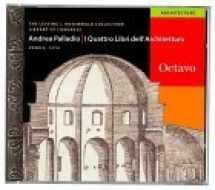
I Quattro Libri dell'Architettura (Italian Edition)
ISBN-13:
9781891788277
ISBN-10:
1891788272
Author:
Andrea Palladio
Publication date:
2000
Publisher:
Octavo
Format:
CD-ROM
178 pages
FREE US shipping
Book details
ISBN-13:
9781891788277
ISBN-10:
1891788272
Author:
Andrea Palladio
Publication date:
2000
Publisher:
Octavo
Format:
CD-ROM
178 pages
Summary
I Quattro Libri dell'Architettura (Italian Edition) (ISBN-13: 9781891788277 and ISBN-10: 1891788272), written by authors
Andrea Palladio, was published by Octavo in 2000.
With an overall rating of 4.5 stars, it's a notable title among other
books. You can easily purchase or rent I Quattro Libri dell'Architettura (Italian Edition) (CD-ROM) from BooksRun,
along with many other new and used
books
and textbooks.
And, if you're looking to sell your copy, our current buyback offer is $0.14.
Description
Andrea Palladio (1508–80) designed many sumptuous buildings in Venice and its hinterland, the Veneto, during the Italian Renaissance. His name is identified with an architectural movement named after him, Palladianism, which emanated from northern Italy and grew in popularity across Europe and, by the eighteenth century, had extended to America. Consequently, he is probably the best-known architect in the Western world. His international fame is due largely to his treatise on architecture, I quattro libri dell’architettura (1570), four books—or chapters—on the tradition of classical architecture, illustrated by his own designs. Through its combination of clear and direct words and images, I quattro libri inspired numerous would-be patrons and architects, including Inigo Jones, architect to the Stuart court in sixteenth-century England. In America, the future president and amateur architect Thomas Jefferson referred to his English translation of I quattro libri as "the Bible." I quattro libri was a product of the Italian Renaissance, which flourished in Florence and Rome before spreading to the other major city-states of Italy. Renaissance architecture reinterpreted the classical tradition of architecture and relied on the built and literary remains of the ancient Roman civilization for its examples. Studies of antiquity, in situ, were an essential part of Palladio’s architectural education and he reasoned that only through such study could the "greatness" of ancient architecture be understood. He believed that an essential contribution to its greatness was the concept of virtù, which was derived from a sound education in the arts and sciences, and the exercise of knowledge and wisdom for the benefit and enhancement of civic life. To illustrate his text, Palladio made spectacular drawings of pagan temples and shrines, basilicas, and the vast Roman baths and arenas, reconstructing the ruins as entire buildings, as he imagined they had been designed—not as damaged or imperfect relics of the past, but as potent symbols of civilized virtù, perfect and complete. Commentary and English translation by Robert Tavernor.


We would LOVE it if you could help us and other readers by reviewing the book
Book review

Congratulations! We have received your book review.
{user}
{createdAt}
by {truncated_author}


